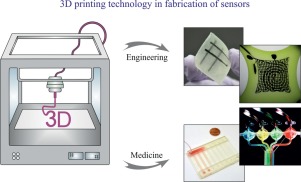Sensors and Actuators A: Physical ( IF 4.1 ) Pub Date : 2020-02-24 , DOI: 10.1016/j.sna.2020.111916 Mohammad Reza Khosravani , Tamara Reinicke

|
Due to the technological advances, sensors have found a significant role in different aspects of human life. The sensors have been fabricated via various manufacturing processes. Recently, additive manufacturing (AM) has become a common method for fabrication of a wide range of engineering components in many industries. This manufacturing method, commonly known as three-dimensional (3D) printing is based on melting and solidification that leads to production of a component with high dimensional accuracy and smooth surface finish. As precision and elegant techniques are needed in manufacturing of the sensors, AM has been utilized in fabrication of these parts in the last few years. In this study, we summarized and classified applications of different AM methods in manufacturing of sensors. In this context, we briefly reviewed and compared AM techniques and categorized 3D-printed sensors based on their applications. Moreover, fabrication of sensors via AM is explained in details, challenges and future prospect of this manufacturing process are discussed. Investigations on the performed studies proved that higher printing resolution, faster speed and higher efficiency are needed to reach a remarkable advance in the production of 3D-printed sensors. The presented data can be utilized not only for comparison, improvement and optimization of fabrication processes, but also is beneficial for next research in production of highly sensitive sensors.
中文翻译:

3D打印传感器:当前的进展和未来的挑战
由于技术的进步,传感器已在人类生活的各个方面发挥了重要作用。传感器是通过各种制造工艺制造的。近年来,增材制造(AM)已成为许多行业中制造各种工程部件的常用方法。通常称为三维(3D)打印的这种制造方法基于熔化和固化,从而可以生产出具有高尺寸精度和平滑表面光洁度的组件。由于传感器的制造需要精密而精致的技术,因此在最近几年中,AM已用于制造这些零件。在这项研究中,我们总结并分类了不同AM方法在传感器制造中的应用。在这种情况下,我们简要回顾并比较了AM技术,并根据其应用对3D打印传感器进行了分类。此外,将详细说明通过AM制造传感器的过程,并讨论该制造过程的挑战和未来前景。对所进行研究的研究证明,需要更高的打印分辨率,更快的速度和更高的效率才能在3D打印传感器的生产中取得显着进步。所提供的数据不仅可以用于制造工艺的比较,改进和优化,而且对于高灵敏度传感器生产中的下一步研究是有益的。对进行的研究的研究证明,需要更高的打印分辨率,更快的速度和更高的效率才能在3D打印传感器的生产中取得显着进步。所提供的数据不仅可以用于制造工艺的比较,改进和优化,而且对于高灵敏度传感器生产中的下一步研究是有益的。对所进行研究的研究证明,需要更高的打印分辨率,更快的速度和更高的效率才能在3D打印传感器的生产中取得显着进步。所提供的数据不仅可以用于制造工艺的比较,改进和优化,而且对于高灵敏度传感器生产中的下一步研究是有益的。









































 京公网安备 11010802027423号
京公网安备 11010802027423号